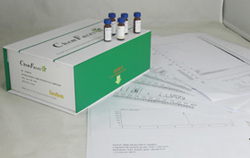Hot Products



| Catalog No. | Information |
| CFN90357 | Isotanshinone IIA Isotanshinone IIA non-competitively inhibits protein tyrosine phosphatase 1B (PTP1B) activity with 50% inhibitory concentration values of 11.4±0.6 μM. PTP1B acts as a negative regulator of insulin signaling, and selective inhibition of PTP1B has served as a potential drug target for the treatment of type 2 diabetes. |
| CFN98722 | Isotetrandrine Isotetrandrine is a small molecule inhibitor, on various aspects of LPS-induced inflammation in vitro and in vivo. It dose-dependently suppresses the severity of LPS-induced ALI by inactivation of MAPK and NF-κB, which may involve the inhibition of tissue oxidative injury and pulmonary inflammatory process. |
| CFN92436 | Isothymonin Isothymonin has antioxidant activity.It displays cyclooxygenase-1 inhibitory activity. |
| CFN97562 | Isothymusin Isothymusin( MIC= 200 microg/mL) exhibits inhibition activity against Mycobacterium tuberculosis. It ( IC50=7.7 microg/mL ) exhibits antioxidant activity against the radical scavenging ability of DPPH. |
| CFN95222 | Isovalerylshikonin Isovalerylshikonin, a new resistance-modifying agent from Arnebia euchroma, supresses antimicrobial resistance of drug-resistant Staphylococcus aureus; it also has anti-mite activity. Isovalerylshikonin as a candidate of AChE inhibitor, it may prevent apoptotic cell death induced by hydrogen peroxide in human and rat neuronal SH-SY5Y and PC12 cells. |
| CFN92419 | Isovanillic acid Isovanillic acid shows distinct anti -inflammatory activities with no toxicity on RAW 264.7 macrophage cells. |
| CFN90358 | Isovanillin Isovanillin is a reversible inhibitor of aldehyde oxidase. It is largely used as pharmaceutical intermediates and also applied in food and beverage industry, synthetic fragrances, chemical. Isovanillin is a selective inhibitor of aldehyde oxidase, is metabolized by aldehyde dehydrogenase into isovanillic acid ,and the LD50 (rat, ipr) is 1276 mg/kg. |
| CFN98620 | Isovitexin Isovitexin, a food phytochemical contained in dietary rice products, it exhibits in vivo α-glucosidase inhibition, it possesses antihyperglycemic, neuroprotective, anti-inflammatory and anti-oxidant activities. Isovitexin inhibited xanthine oxidase with an IC50 value of 15.2 microM, it may protect cells from oxidative stress. It inhibited JNK, MAPK and NF-κB and activated HO-1/Nrf2 pathways. |
| CFN90943 | Isovitexin 2''-O-arabinoside Isovitexin 2''-O-arabinoside is a natural product from Secale cereale. |
| CFN95314 | Isovitexin-2''-O-rhamnoside (2''-O-alpha-L-Rhamnopyranosyl-isovitexin) Isovitexin 2′′-O-rhamnoside, a phenolic, has antioxidant and antiproliferative activities. |